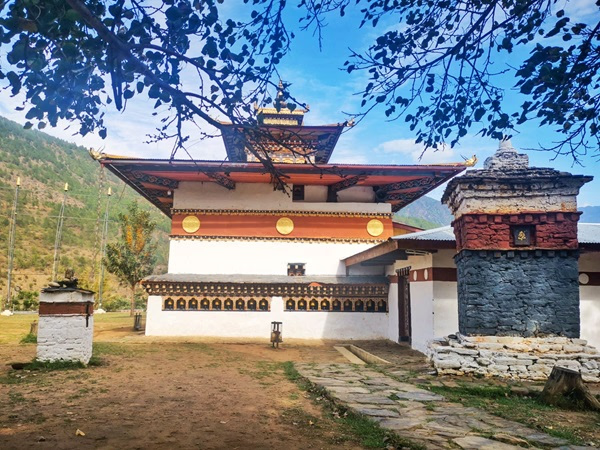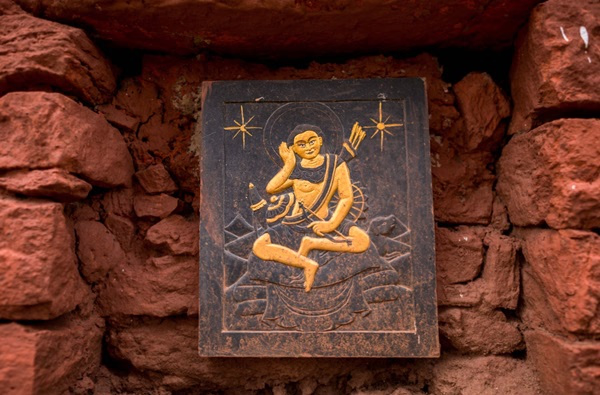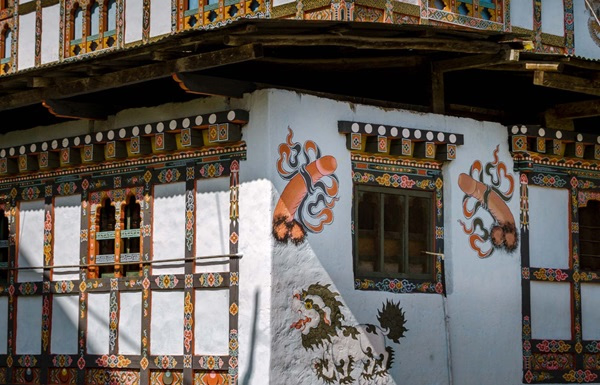
Chimi Lhakhang is a popular Buddhist monastery in Bhutan. It is located near Sopsokha village in the Punakha District of Bhutan. Pilgrims and tourists have to take a stroll for 20 minutes through the beautiful rice and mustard fields to access the monastery.
Popularly known as The Fertility Temple, the monastery idyllically stands on a round hillock surrounded by scenic views. Built over half a millennium ago, it’s one of the oldest monasteries in Bhutan.
1. The Legend Of Drukpa Kunley
Chimi Lhakhang was built in 1499 by Ngawang Choegyel, the 14th Drukpa hierarch. However, the temple wasn't the first structure on the site. It was Drukpa Kunley (1455–1529), the maverick saint also known as the "Divine Madman," who first built a chorten at this location after blessing it. According to legend, Lama Kunley blessed the site for Chimi Lhakhang after subduing the demoness of Dochu La at this very spot. Drukpa Kunley used the "magic thunderbolt of wisdom" to subdue the demoness.
Close to the chorten that he built is giant rock, and below it is where the Dochu La demon is trapped. Drukpa Kunley is also given the name ‘Divine Madman’ or ‘Mad Saint’ for his unorthodox methods of teaching ‘Buddhism’. His methods of teaching the religion were marked by humor and many forms of outrageous behavior.
Drukpa Kunley’s ways of teaching Buddhism were shocking and bizarre, with sexual overtones. According to local legends, Drukpa Kunley had supernatural powers and could correctly predict the death of other Lamas.
2. The Temple Of Fertility Attracts Thousands Of Pilgrims Every Year

The Lama is sometimes also referred to as ‘The Saint of 5,000 Women’ due to his truly pleasure-filled lifestyle full of women and wine. He propagates intercourse as a manner to attain enlightenment. That’s the origin of the monastery’s alleged fertility-inducing powers. It is said that all those who wish to conceive will receive fertility blessings at the monastery.
The Fertility Temple flocks with thousands of pilgrims who hope to have a child. Others visit the temple seeking blessings or wang from the saint with the ‘magic thunderbolt of wisdom.’
Those with new-born children often visit the local Lama to get their children bestowed with resounding forenames. You can also visit the Lamas even if you are not looking for fertility or blessings of any kind − there’s a lot to learn about the culture and history of the Bhutanese at Chimi Lhakhang.
3. Chimi Lhakhang Is Home To The Original Wooden Phallus Symbol

Chimi Lhakhang is the repository of the original wooden phallus symbol brought by Drukpa Kunley from Tibet. The giant wooden phallus is used to bless the people who visit the monastery, especially women who are looking to conceive. The 25cm (10 inches) wooden phallus has a silver handle and is also said to repel evil eyes and malicious gossip. The phallus is a symbol commonly found throughout the country.
In the village of Sopsokha near the monastery, all the houses bear paintings of phalluses on their exterior walls.
4. Visitors Enjoy The Easy Hike To Chimi Lhakhang
 Image Credit: Unsplash
Image Credit: Unsplash
The hike to Chimi Lhakhang is a scenic 20-minute walk through beautiful rice fields and rural villages. The path is fairly easy, offering visitors a peaceful journey through the Bhutanese countryside.
Along the way, travelers will encounter prayer flags and traditional houses adorned with phallic symbols, reflecting the temple's unique association with fertility. Wearing comfortable walking shoes is recommended, and it’s a good idea to bring water and a hat for sun protection.
5. Phallic Symbols Are Also Believed To Provide Protection
In Bhutanese culture, phallic symbols are tied to fertility and are believed to ward off evil spirits and protect households. This practice, particularly prominent at Chimi Lhakhang, dates back to the teachings of Drukpa Kunley.
The phallic imagery, often painted on homes and buildings around the temple, is thought to invoke Kunley’s irreverent yet powerful methods of subduing negative forces. This dual purpose—fertility and protection—adds a layer of spiritual depth to the temple’s significance in Bhutanese tradition.
Conclusion About Chimi Lhakhang
Chimi Lhakhang remains a unique spiritual destination in Bhutan, offering visitors a chance to experience local culture, fertility blessings, and beautiful landscapes.
Its rich history tied to the Divine Madman, along with the sacred rituals performed there, make it a must-see for travelers seeking more than just sightseeing.
Druk Asia offers bespoke tour packages to explore Chimi Lhakhang and other cultural treasures of Bhutan, ensuring an immersive experience into Bhutanese traditions and landscapes. Plan your visit with a reliable Bhutan tour agency for a seamless journey!
Frequently Asked Questions About Chimi Lhakhang
Is There A Dress Code For Visiting Chimi Lhakhang?
Visitors are required to dress modestly when visiting Chimi Lhakhang. Both men and women should wear clothing that covers their shoulders and knees as a sign of respect for the religious site.
What Is The Best Time Of Year To Visit Chimi Lhakhang?
The best time to visit Chimi Lhakhang is during the spring and autumn months (March to May and September to November) when the weather is mild and the surrounding landscape is lush and green.
How Do I Get To Chimi Lhakhang?
Chimi Lhakhang is accessible by road from Punakha town. Visitors can alight at the trailhead and then hike for about 20-30 minutes through scenic rice fields and villages to reach the temple.
Can Visitors Receive Blessings For Fertility At Chimi Lhakhang?
Yes, visitors can receive blessings for fertility at Chimi Lhakhang. The resident monk or lama may perform special rituals and prayers to bless couples seeking fertility.